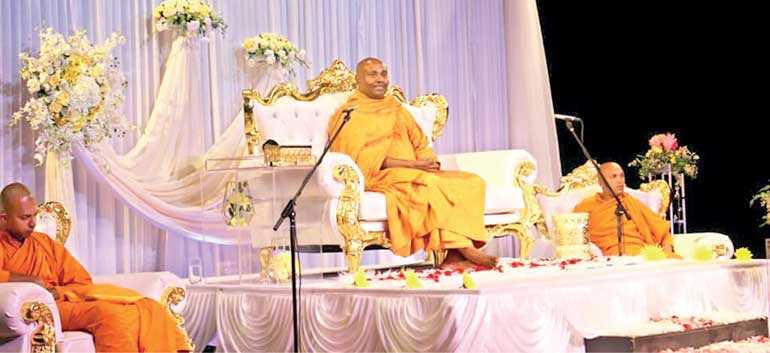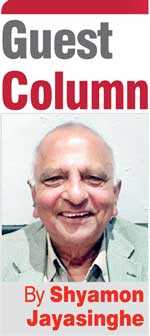Tuesday Mar 18, 2025
Tuesday Mar 18, 2025
Thursday, 7 March 2019 00:34 - - {{hitsCtrl.values.hits}}

The phenomenon
Judging by the crowds he is gathering around him, this latest monk-sensation in Sri Lanka is on a success tide. Thousands pilgrimage to him at home. The rich and the poor liberally donate pirikara or gifts. Ambitious politicians flock around hoping for sponsorship. Overseas, an eager diaspora awaits him.
There is strangely little distinction between the educated classes and the barely illiterate when it comes to religious following among Third World people. The poorer the people, the more religiosity. The readiness to believe prevails. Critical faculties are pushed aside. This is the stuff of life!
The claim of Arahat status
Briefly put, Revd. Pitiduwe Samanthabhadra self-claims he has reached the summit of Arahat state.
In Theravada Buddhism there are three states before reaching Buddhahood or enlightenment. These are (in order of ascent) Sowan, Sakurdagamee, Anagaami and Arahat. Being the sublime state just before hitting the target, Arahat is a condition of great ‘holiness.’
An Arahat is a person who has eliminated all the unwholesome roots which underlie the fetters – who upon their death will not be reborn in any world, since the bonds (fetters) that bind a person to the samsara have been finally dissolved. In the Pali Canon, the term ‘tathagatha,’ is sometimes used as a synonym for Arahat, though the former usually refers to the Buddha alone.
 The Mahisasaka and the Theravada regarded Arahats and Buddhas as being similar to one another. The 5th century Theravadin commentator Buddhagosa regarded Arahats as having completed the path to enlightenment. According to Bhikku Bodi the Pali Canon portrays the Buddha declaring himself to be an Arahat. According to Bhikkhu Bodhi, nirvāṇa is “the ultimate goal,” and one who has attained nirvana has attained Arahant-ship: Bhikkhu Bodhi writes, “The defining mark of an Arahat is the attainment of nirvāṇa in this present life.”
The Mahisasaka and the Theravada regarded Arahats and Buddhas as being similar to one another. The 5th century Theravadin commentator Buddhagosa regarded Arahats as having completed the path to enlightenment. According to Bhikku Bodi the Pali Canon portrays the Buddha declaring himself to be an Arahat. According to Bhikkhu Bodhi, nirvāṇa is “the ultimate goal,” and one who has attained nirvana has attained Arahant-ship: Bhikkhu Bodhi writes, “The defining mark of an Arahat is the attainment of nirvāṇa in this present life.”
Methodological problem
Let us examine the monk’s claim through the lenses of scientific thought. The first thing that occurs to me is, how could a claim of an individual be tested for truth by others? It is just a claimant’s claim and it emerges and ends inside the latter’s psyche. If you visit any mental hospital you are bound to meet a patient who claims he is ‘emperor’. In the latter instance at least you know the man is sick and thereupon you just pass on without being impressed.
On the other hand, even in a perfectly normal-looking man delusions can occur. On the assumption that the latter’s claim is sincerely and honestly being made, it is human experience that self-delusions do occur – at least temporarily. Given that such assumption cannot be made, then the claimant is a poser or pretender and society has to be cautious of him. My problem is that there simply isn’t any evidence for accepting our Rev. Samanthabhadra’s claim to this supreme state.
Absence of peer support
The result is that this monk’s version of himself has been disregarded and viewed with suspicion by the rest of the Sangha or community of monks in Sri Lanka and overseas. When the monk goes overseas he takes with him two young faithfuls to demonstrate the Sangha community’s acceptance of his claim to Arahat-hood.
The picture in this article was taken from the recent Melbourne presentation of this monk. Note how the two young monks are seated at several levels lower than him. Rev. Samanthabhadra is seated atop in a special chair. In Sri Lanka he has something like a throne and he is enthroned! The organisers could not get a Melbourne monk to do that as there is no peer acceptance of the claim by the monk. They managed to get some pretty girls to present flowers to the monk.
Eloquence
One sure thing about Rev. Samanthabhadra is his impressive articulation of ideas. The gift of the tongue is what carries him. And, to be honest, he does come out with some good insight and ideas. The audience is rarely disappointed and so had been the Melbourne crowd. He has a great flexibility of mind and an impressive intellectual presence. It isn’t all fair to condemn him all round as many critics are prone to do.
Sri Lanka has a serious problem on its hands of having low critical levels in its population. There is an urgent need for a revolution in our school and mass education
Criticism
There are some studied critical observations about this monk in a published article by Professor Kapila Abhayawanse. Professor Abhayawanse is Vice-Rector at the International Buddhist College in Thailand and Professor of Buddhist Studies. He is among the best of Sri Lankan Buddhist scholars today.
Professor Abhayawanse believes that Rev. Samanthabhadra is insulting the religion rather than extolling it. He has based his observations on a study of the numerous YouTube presentations of the latter’s performances.
Reading Abhayawanse and adding my own perception of him, there isn’t any doubt that the monk is a public performer. Rev. Samanthabhadra wants effect or impact. Like a theatre man, he performs for an audience. The audience is the key thing and he knows that.
Imitates Buddha
Professor Kapila notes that this monk has tuned in his appearances to be like that of the Buddha himself. Professor Kapila says that often he emerges in the style of the Buddha’s appearance as described in the Sutta texts, resonating with the sermons of the Buddha at Jethawanaramaya.
The monk’s faithfuls have studied that and they make elaborate colourful arrangements. The path is strewn with flowers and the Bana Mandapaya is special. As he makes his entry, he is applauded with a greeting that was exactly what was given to the Buddha in his early appearances. The monk acknowledges that royal greeting and sits. Says Abhayawanse, “This is the first time in the long and ancient history of the Sangha that was established by Sariyuth Mugalan, do we observe a local monk doing an ‘actor’s role’ like this.”
The fact is, according to our Professor, that Rev. Samanthabhadra equates himself to the Buddha himself. The very term ‘Samanthabhadra’ is an optional usage for the Buddha.
The Professor states that in many of his sermons Rev. Samanthabhadra suggests that he has “revealed the truth” that others haven’t revealed. To Buddhists, this appears as another attempt to be on par with the Buddha. Buddhists, on the other hand, believe that after the Enlightened One there is no more truth to be revealed.
The central truth first revealed by the Buddha is the truth that reality is governed by the operation of Prtatiya Samuppada (Dependent Origination). It is explains our predicament and explains how to emancipate ourselves from that. Samanthabhadra is observed twisting that doctrine in order to give the impression that it is something of his own originality.
Professor Kapila observes that whenever he is accused by someone of certain weaknesses, the monks turns around and attempts to rationalise these lapses by arguing that the Buddha himself had such weaknesses. Once, when he was accused of taking photographs in layman’s kit, putting his robes away, the monk charged that the Buddha himself did that. There is no evidence for such conduct by the Buddha, says the Professor.
Similarly, this monk is accused of hurling inappropriate language at critics who question his claims to Arahat-hood. In his defence, the monk states that such accusations were also made of the Buddha. Professor Kapila points out that this is not true as all Sutta texts refer in glowing terms about the great dignity with which the Buddha spoke and met his critics.
Distortions
Fourth, Professor Kapila mentions some instances where Rev. Samanthabhadra has distorted Buddha’s teaching. He gives the example of the monk’s interpretation of the arising of Bhavaya. According to the Buddha, Bhavaya arises from attachment (Upaadaana). On the other hand, this monk states that Bhavaya does not necessarily derive from attachment. This monk has also stated that all religions assert the same thing. This is absolutely false, urges Professor Kapila.
Body language
Professor Kapila also makes references to the body language, mannerisms and gestures of this monk and describes them as being far removed from that of an Arahat. I thought as much during the many times I have observed this monk in action. Even on the bed of flowers arranged for him to walk on, he gesticulates in a most ungainly manner. An Arahat who has ‘extinguished all fires within’ would be expected to walk in a detached way; but not so our Arahat. Rev. Samanthabhadra speaks fast and actions with a rustic layman’s thrust. He shows belligerence. In fact, there was a report of him that alleged a physical duel with another monk at Kiribathgoda.
Critical sense of our people
If the picture given above is true, then Sri Lanka has a serious problem on its hands of having low critical levels in its population. There is an urgent need for a revolution in our school and mass education. People are credulous and willing to believe anything.
This may be why we have such poor politics and such poor governance in our country.
What has our free education done for us? Our teachers have not imparted the vital discipline of critical thinking. Our school curriculum hasn’t got anything like this. Even students of science subjects confine their study to the subject specific area and never to the scientific mode of thinking on evidence lines and reasoning methods that lies underneath these subjects they do.
Our print and digital media give no leadership here. Television time is taken by astrologers and soothsayers. Political leaders in their own publicly-expressed superstitious worldviews only serve to consolidate the uncritical thinking levels of our population; every time they break coconuts at the Seenugama Devale, for instance, they help to crystallise public acceptance of superstition.
(The writer can be reached via [email protected].)
Discover Kapruka, the leading online shopping platform in Sri Lanka, where you can conveniently send Gifts and Flowers to your loved ones for any event including Valentine ’s Day. Explore a wide range of popular Shopping Categories on Kapruka, including Toys, Groceries, Electronics, Birthday Cakes, Fruits, Chocolates, Flower Bouquets, Clothing, Watches, Lingerie, Gift Sets and Jewellery. Also if you’re interested in selling with Kapruka, Partner Central by Kapruka is the best solution to start with. Moreover, through Kapruka Global Shop, you can also enjoy the convenience of purchasing products from renowned platforms like Amazon and eBay and have them delivered to Sri Lanka.
Discover Kapruka, the leading online shopping platform in Sri Lanka, where you can conveniently send Gifts and Flowers to your loved ones for any event including Valentine ’s Day. Explore a wide range of popular Shopping Categories on Kapruka, including Toys, Groceries, Electronics, Birthday Cakes, Fruits, Chocolates, Flower Bouquets, Clothing, Watches, Lingerie, Gift Sets and Jewellery. Also if you’re interested in selling with Kapruka, Partner Central by Kapruka is the best solution to start with. Moreover, through Kapruka Global Shop, you can also enjoy the convenience of purchasing products from renowned platforms like Amazon and eBay and have them delivered to Sri Lanka.